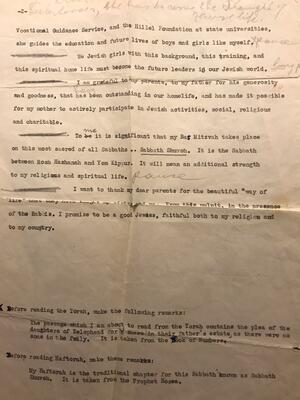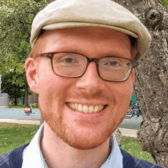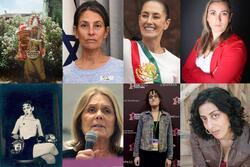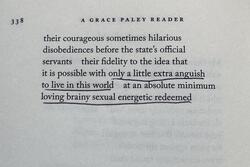A Reform Synagogue's First Bat Mitzvah
The first page of the original type-written speech that Roslyn Lieberman Horwich delivered at her bat mitzvah in 1940–41 at Temple B’nai Abraham Zion in Oak Park, Illinois. She was the congregation's first bat mitzvah. Photo courtesy of Bruce Horwich, Roslyn's son. The original is now held at the American Jewish Archives.
I have the privilege of serving as the associate rabbi of Oak Park Temple B’nai Abraham Zion in Oak Park, Illinois, and recently officiated at the funeral of Roslyn Lieberman Horwich (1928-2020). I had been told she was our congregation’s first bat mitzvah. While this is the kind of family legend that could easily have been embellished in transmission, I was delighted and surprised when Roslyn’s son, Bruce Horwich, uncovered the artifact that brought the story to life: the yellowed, type-written speech, complete with handwritten notes, that she delivered from the temple’s pulpit.
On the Sabbath between Rosh Hashanah and Yom Kippur of 1940 or 1941, Roslyn Lieberman addressed the rabbis and congregants of the Washington Boulevard Temple (B’nai Abraham Zion), as it was then called. Her speech begins:
Dear Parents, Rabbis and Friends,
I feel honored and happy to know that I am the first girl in our Temple to have the privilege of being Bas Mitzvah. It has been the custom in Reform Congregations to celebrate confirmation for boys, and girls, alike, at the age of approximately fourteen. In recent years, we have added to our Reform ritual the observance of the Bar Mitzvah, and in some Temples, also the Bas Mitzvah. Our Rabbis have given me the privilege of being the first girl in our Temple to be Bas Mitzvah.
As her d’var Torah makes clear, this was a momentous occasion not only in the history of our temple but also in Roslyn’s young life. This wouldn’t be Roslyn’s last broken barrier. She would go on to raise three sons as a rare 1950s divorcee, and she would forge a career, starting as a salesperson at Marshall Fields and eventually owning twenty travel agencies and working closely with well-known businessman Robert Pritzker.
Roslyn witnessed innumerable changes during her 92 years on Earth, not the least of which were the shifting roles of women in American society. Even at the age of twelve or thirteen, Roslyn was able to reflect on the growth of women’s activity in the Jewish community. As she shared from the Washington Boulevard pulpit:
In the course of our history, many changes have taken place in the religion and ritual of Judaism. Among these changes is the place and function of the Jewish woman in the synagogue. In the olden days she took no part in religious, business or social life. The Jewish woman of today in the Reform Congregations prays side by side with her husband. She observes all the holidays both in her home and in her Synagogue. She has affiliated herself with Jewish charities, such as the help to the aged, crippled, blind and orphaned. The Jewish woman takes active participation in the rebuilding of Palestine through Hadassah. She takes active part in the legislation against anti-semitism, and anti-defamation, through the American Jewish Congress and B’nai Brith. Through the Vocational Guidance Service, and the Hillel Foundation at state universities, she guides the education and future lives of boys and girls like myself.

The second page of the original type-written speech that Roslyn Lieberman Horwich delivered at her bat mitzvah in 1940–41 at Temple B’nai Abraham Zion in Oak Park, Illinois. She was the congregation's first bat mitzvah. Photo courtesy of Bruce Horwich, Roslyn's son. The original is now held at the American Jewish Archives.
These reflections are a testament to the impact that early 20th century Jewish women had on young people like Roslyn. Though she herself would not go on to join Hadassah, Hillel, or B’nai Brith, these organizations nevertheless contributed to her confidence and ambition, paving the way for her to chart her own life’s course.
The historical moment surrounding Roslyn’s bat mitzvah is worth noting. The rabbis at the time—Samuel Schwartz and W. Gunther Plaut— don't mention the congregation’s first bat mitzvah in their autobiographies (Tell Thy Children and Unfinished Business). But the occasion clearly impacted Roslyn and, ultimately, our entire community.
Personally, I am proud that our congregation encouraged Roslyn to become bat mitzvah so early in the life of that ritual. The very first public bat mitzvah was celebrated less than twenty years earlier by Judith Kaplan in 1922. While her father, Mordecai Kaplan, was the intellectual forebear of Reconstructionist Judaism, it was in Conservative congregations that the bat mitzvah ceremony was, at first, most celebrated.
Curiously, Reform Judaism’s commitment to egalitarianism actually served as an obstacle to the recognition of the bat mitzvah in most Reform synagogues. Since the nineteenth century, the Reform movement had focused on the (newly formed) confirmation ceremony, largely abandoning the bar mitzvah service altogether. As Paula Hyman explains, “Equality for women in the Reform Movement had sources other than the bat mitzvah, although there were some bat mitzvah ceremonies in Reform temples from 1931.” Thus Roslyn’s 1940/1941 ceremony was a rare occasion, and even rarer is the first-person artifact that directly attests to the groundbreaking accomplishment.
Roslyn Lieberman Horwich’s life was extraordinary and would have been nearly impossible to imagine a generation earlier. The young woman who spoke so eloquently at her bat mitzvah would nurture, challenge, and inspire many others. The charge she gave to her congregation was powerful then and continues to resonate today: “We Jewish girls with this background, this training, and this spiritual home life must become the future leaders in our Jewish world… From this pulpit, in the presence of the Rabbis, I promise to be a good Jewess, faithful both to my religion and to my country.”








I stumbled across your article about the Bas Mitzvah of Roslyn Lieberman Horwich in trying to determine when Bat Mitzvahs became common in Reform Judaism. The surprise was finding an article by the Rabbi of the Oak Park Temple, where I was a Bas Mitzvah in January of 1960, when Rabbi Schwartz and Rabbi Mervis were leading the congregation. My memory is that there were not a lot of girls my age in the Bas Mitzvah program, but perhaps I've forgotten. My mother, Ann Kohout, was Rabbi Mervis' secretary, which might have had something to do with the decision. I was married by Rabbi Schwartz because he was willing to officiate at a ceremony between a Jew and a non Jew. We raised our daughter in Denver as members of Temple Emanuel. I have been a board member and congregational leader at both Sha'ar Zahav in SF and now at the Mendocino Coast Jewish Community. My Bat Mitzvah, Confirmation, and Jewish education were extremely important parts of my young life.
Thanks for your interesting article about Roslyn. I was very nervous and, I'm sure, had nothing profound or inspirational to say on the day of my Bas Mitzvah. She was some gal!